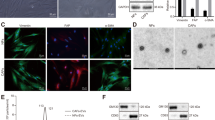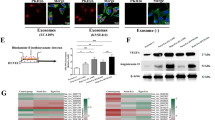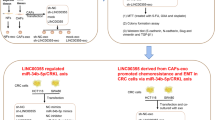Abstract
Cancer-associated fibroblast (CAF) secretes extracellular vesicle (EV)-encapsulated microRNAs (miRNAs) which have been underlined great promise for therapeutic target for diseases and cancers. Our study aimed to explore the role of EV-encapsulated miR-10a-5p from CAFs in angiogenesis in cervical cancer. Expression of miR-10a-5p in clinical samples of cervical cancer and cancer cells was detected by in situ hybridization and RT-qPCR. Results demonstrated that miR-10a-5p expression was upregulated in both cancer tissues and cells. CAFs and normal fibroblasts (NFs) from cervical cancer patient tissues were characterized under transmission electron microscopy, followed by EV isolation from CAFs. The EVs labeled with PKH67 were cultured with cervical squamous cell carcinoma (CSCC) cell line (SiHa) and HUVECs. Data indicated that CAF-EVs were internalized by cancer cells and promoted cell proliferation and tube formation. CAF-EVs then were transfected with miR-10a-5p inhibitor and then injected into nude mice. While injection of CAF-EVs promoted tumor growth and increased VEGFR and CD31 expression level, miR-10a-5p inhibitor-treated CAF-EVs resulted in decreased tumor volume and amount of vessel around tumor. Of note, dual-luciferase reporter gene assay and bioinformatic analysis indicated TBX5 as a target gene of miR-10a-5p. Moreover, EV-derived miR-10a-5p promoted angiogenesis in vivo and in vitro through activation of Hedgehog signaling via downregulation of TBX5. Taken altogether, miR-10a-5p in CAF-EVs promoted CSCC cell angiogenesis and tumorigenicity via activation of Hh signaling by inhibition of TBX5, providing insight into novel treatment based on miR-10a-5p against CSCC.
This is a preview of subscription content, access via your institution
Access options
Subscribe to this journal
Receive 12 print issues and online access
$259.00 per year
only $21.58 per issue
Buy this article
- Purchase on Springer Link
- Instant access to full article PDF
Prices may be subject to local taxes which are calculated during checkout








Similar content being viewed by others
References
Cohen PA, Jhingran A, Oaknin A, Denny L. Cervical cancer. Lancet. 2019;393:169–82.
Sawaya GF, Smith-McCune K, Kuppermann M. Cervical cancer screening: more choices in 2019. JAMA. 2019;321:2018–9.
Roudsari LC, West JL. Studying the influence of angiogenesis in in vitro cancer model systems. Adv Drug Deliv Rev. 2016;97:250–9.
Jayson GC, Kerbel R, Ellis LM, Harris AL. Antiangiogenic therapy in oncology: current status and future directions. Lancet. 2016;388:518–29.
Tewari KS, Sill MW, Long HJ 3rd, Penson RT, Huang H, Ramondetta LM, et al. Improved survival with bevacizumab in advanced cervical cancer. N. Engl J Med. 2014;370:734–43.
Erez N, Truitt M, Olson P, Arron ST, Hanahan D. Cancer-associated fibroblasts are activated in incipient neoplasia to orchestrate tumor-promoting inflammation in an NF-kappaB-dependent manner. Cancer Cell. 2010;17:135–47.
Chen X, Song E. Turning foes to friends: targeting cancer-associated fibroblasts. Nat Rev Drug Disco. 2019;18:99–115.
Todorova D, Simoncini S, Lacroix R, Sabatier F, Dignat-George F. Extracellular vesicles in angiogenesis. Circ Res. 2017;120:1658–73.
Becker A, Thakur BK, Weiss JM, Kim HS, Peinado H, Lyden D. Extracellular vesicles in cancer: cell-to-cell mediators of metastasis. Cancer Cell. 2016;30:836–48.
Hu X, Schwarz JK, Lewis JS Jr., Huettner PC, Rader JS, Deasy JO, et al. A microRNA expression signature for cervical cancer prognosis. Cancer Res. 2010;70:1441–8.
Xu R, Rai A, Chen M, Suwakulsiri W, Greening DW, Simpson RJ. Extracellular vesicles in cancer - implications for future improvements in cancer care. Nat Rev Clin Oncol. 2018;15:617–38.
Cho YK, Son Y, Kim SN, Song HD, Kim M, Park JH, et al. MicroRNA-10a-5p regulates macrophage polarization and promotes therapeutic adipose tissue remodeling. Mol Metab. 2019;29:86–98.
Long MJ, Wu FX, Li P, Liu M, Li X, Tang H. MicroRNA-10a targets CHL1 and promotes cell growth, migration and invasion in human cervical cancer cells. Cancer Lett. 2012;324:186–96.
Worst TS, Previti C, Nitschke K, Diessl N, Gross JC, Hoffmann L, et al. miR-10a-5p and miR-29b-3p as extracellular vesicle associated prostate cancer detection markers. Cancers. 2019;12:43.
Li W, Zhang X, Wang J, Li M, Cao C, Tan J, et al. TGFbeta1 in fibroblasts-derived exosomes promotes epithelial-mesenchymal transition of ovarian cancer cells. Oncotarget. 2017;8:96035–47.
Kumar V, Donthireddy L, Marvel D, Condamine T, Wang F, Lavilla-Alonso S, et al. Cancer-associated fibroblasts neutralize the anti-tumor effect of CSF1 receptor blockade by inducing PMN-MDSC infiltration of tumors. Cancer Cell. 2017;32:654–68.
Kong F, Li L, Wang G, Deng X, Li Z, Kong X. VDR signaling inhibits cancer-associated-fibroblasts’ release of exosomal miR-10a-5p and limits their supportive effects on pancreatic cancer cells. Gut. 2019;68:950–1.
Sommerova L, Anton M, Bouchalova P, Jasickova H, Rak V, Jandakova E, et al. The role of miR-409-3p in regulation of HPV16/18-E6 mRNA in human cervical high-grade squamous intraepithelial lesions. Antivir Res. 2019;163:185–92.
Ma R, Yang Y, Tu Q, Hu K. Overexpression of T-box transcription factor 5 (TBX5) inhibits proliferation and invasion in non-small cell lung carcinoma cells. Oncol Res. 2017;25:1495–504.
Xu H, Xiang M, Qin Y, Cheng H, Chen D, Fu Q, et al. Tbx5 inhibits hedgehog signaling in determination of digit identity. Hum Mol Genet. 2020;29:1405–16.
Feng J, Wang C, Liu T, Li J, Wu L, Yu Q, et al. Procyanidin B2 inhibits the activation of hepatic stellate cells and angiogenesis via the Hedgehog pathway during liver fibrosis. J Cell Mol Med. 2019;23:6479–93.
The Lancet O. Global elimination of cervical cancer is achievable-with commitment. Lancet Oncol. 2019;20:1467.
Sahai E, Astsaturov I, Cukierman E, DeNardo DG, Egeblad M, Evans RM, et al. A framework for advancing our understanding of cancer-associated fibroblasts. Nat Rev Cancer. 2020;20:174–86.
Chu TY, Yang JT, Huang TH, Liu HW. Crosstalk with cancer-associated fibroblasts increases the growth and radiation survival of cervical cancer cells. Radiat Res. 2014;181:540–7.
Yang X, Li Y, Zou L, Zhu Z. Role of exosomes in crosstalk between cancer-associated fibroblasts and cancer cells. Front Oncol. 2019;9:356.
Xie F, Zhou X, Fang M, Li H, Su P, Tu Y, et al. Extracellular vesicles in cancer immune microenvironment and cancer immunotherapy. Adv Sci (Weinh). 2019;6:1901779.
Kalluri R. The biology and function of fibroblasts in cancer. Nat Rev Cancer. 2016;16:582–98.
Yang F, Ning Z, Ma L, Liu W, Shao C, Shu Y, et al. Exosomal miRNAs and miRNA dysregulation in cancer-associated fibroblasts. Mol Cancer. 2017;16:148.
Pedroza-Torres A, Lopez-Urrutia E, Garcia-Castillo V, Jacobo-Herrera N, Herrera LA, Peralta-Zaragoza O, et al. MicroRNAs in cervical cancer: evidences for a miRNA profile deregulated by HPV and its impact on radio-resistance. Molecules 2014;19:6263–81.
Wang X, Ling CC, Li L, Qin Y, Qi J, Liu X, et al. MicroRNA-10a/10b represses a novel target gene mib1 to regulate angiogenesis. Cardiovasc Res. 2016;110:140–50.
Holm LJ, Haupt-Jorgensen M, Larsen J, Giacobini JD, Bilgin M, Buschard K. L-serine supplementation lowers diabetes incidence and improves blood glucose homeostasis in NOD mice. PLoS ONE. 2018;13:e0194414.
Hussain N, Zhu W, Jiang C, Xu J, Wu X, Geng M, et al. Down-regulation of miR-10a-5p in synoviocytes contributes to TBX5-controlled joint inflammation. J Cell Mol Med. 2018;22:241–50.
Lau ST, Li Z, Pui-Ling Lai F, Nga-Chu Lui K, Li P, Munera JO, et al. Activation of Hedgehog signaling promotes development of mouse and human enteric neural crest cells, based on single-cell transcriptome analyses. Gastroenterology. 2019;157:1556–71.
Wang YF, Yang HY, Shi XQ, Wang Y. Upregulation of microRNA-129-5p inhibits cell invasion, migration and tumor angiogenesis by inhibiting ZIC2 via downregulation of the Hedgehog signaling pathway in cervical cancer. Cancer Biol Ther. 2018;19:1162–73.
Xie L, Hoffmann AD, Burnicka-Turek O, Friedland-Little JM, Zhang K, Moskowitz IP. Tbx5-hedgehog molecular networks are essential in the second heart field for atrial septation. Dev Cell. 2012;23:280–91.
Funding
This study was supported by Sichuan Science and Technology Program of China (No. 2018SZ0248/2019YFS0404).
Author information
Authors and Affiliations
Contributions
Conceptualization: Xun Zhang and Yujue Wang; methodology: Xue Peng and Zhao Wu; software: Xue Wang; validation: Xue Peng; formal analysis: Xun Zhang; investigation: Bingyu Zou and Jie Mei; resources: Xun Zhang and Yujue Wang; data curation: Yujue Wang; writing—original draft: Xun Zhang and Yujue Wang; writing—review & editing: Xue Wang, Bingyu Zou, Jie Mei, Xue Peng, and Zhao Wu; visualization: Xue Peng; supervision: Zhao Wu; project administration: Zhao Wu.
Corresponding authors
Ethics declarations
Conflict of interest
The authors declare that they have no conflict of interest.
Ethical approval
The experiment was approved by the Ethics Committee of Sichuan Academy of Medical Sciences & Sichuan Provincial People’s Hospital and conducted in compliance with the Declaration of Helsinki. All individuals signed informed written consent documents. The experiments involving animals followed the recommendations in the Guide for the Care and Use of Laboratory Animals of the National Institutes of Health.
Additional information
Publisher’s note Springer Nature remains neutral with regard to jurisdictional claims in published maps and institutional affiliations.
Rights and permissions
About this article
Cite this article
Zhang, X., Wang, Y., Wang, X. et al. Extracellular vesicles-encapsulated microRNA-10a-5p shed from cancer-associated fibroblast facilitates cervical squamous cell carcinoma cell angiogenesis and tumorigenicity via Hedgehog signaling pathway. Cancer Gene Ther 28, 529–542 (2021). https://doi.org/10.1038/s41417-020-00238-9
Received:
Revised:
Accepted:
Published:
Issue Date:
DOI: https://doi.org/10.1038/s41417-020-00238-9
This article is cited by
-
Cancer-associated fibroblast-derived extracellular vesicles promote lymph node metastases in oral cavity squamous cell carcinoma by encapsulating ITGB1 and BMI1
BMC Cancer (2024)
-
Cancer-associated fibroblast-derived exosome microRNA-21 promotes angiogenesis in multiple myeloma
Scientific Reports (2023)
-
The role of Hedgehog and Notch signaling pathway in cancer
Molecular Biomedicine (2022)
-
Exosomes and cancer - Diagnostic and prognostic biomarkers and therapeutic vehicle
Oncogenesis (2022)
-
The functions and potential roles of extracellular vesicle noncoding RNAs in gynecological malignancies
Cell Death Discovery (2021)



